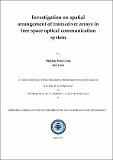Please use this identifier to cite or link to this item:
http://drsr.daiict.ac.in//handle/123456789/453Full metadata record
| DC Field | Value | Language |
|---|---|---|
| dc.contributor.advisor | Ghosh, Anjan | |
| dc.contributor.author | Panchratna, Digvijay | |
| dc.date.accessioned | 2017-06-10T14:40:56Z | - |
| dc.date.available | 2017-06-10T14:40:56Z | - |
| dc.date.issued | 2013 | |
| dc.identifier.citation | Panchratna, Digvijay (2013). Investigation on spatial arrangement of transceiver arrays in free space optical communication system. Dhirubhai Ambani Institute of Information and Communication Technology, ix, 46 p. (Acc.No: T00416) | |
| dc.identifier.uri | http://drsr.daiict.ac.in/handle/123456789/453 | - |
| dc.description.abstract | Free space optical communication (FSO) is a line of sight communication that uses lasers (as transmitter) and photo detectors (as receiver) to provide communication between two points. FSO have come about in need for greater bandwidth and improved reliable communication system. As optical frequency ranges is in terahertz i.e. from 1012 to 1016 Hz, so FSO system offers huge bandwidth and hence increased data transmitting capabilities. For an atmospheric channel the characteristics of channel are not in our control, so the performance of a FSO system is degraded by atmospheric effects. Fog, smoke, rain, snow, dust particles etc. are responsible for attenuation of the transmitted laser beam. But the main factor that is responsible for fading of the signal is the scintillation effect. Scintillation causes fluctuations in both intensity and the phase of the received signal, impairing the link performance. SIMO (Single input multiple output) and MIMO (Multiple input multiple output) systems are commonly deployed in order to combat the fading due to scintillation. But for a SIMO free space optical communication link the number of detectors to be used to deliver the maximum SNR and their position is still unknown. The curiosity of our work lies in designing the receiver array i.e. the number of detectors to be used to deliver the maximum SNR and their arrangements. In our approach, we used the concept of power with misalignment and spatial arrangement methods to come up with the problem statement. In this thesis, we have proposed two methods: 1. Deterministic method and 2. the Monte Carlo method, to find out the number of detectors and their arrangements for maximum SNR. Considering the weak turbulence regime we have modelled the channel to be log-normally distributed. In our work we have analyzed the link for both the cases i.e. with and without scintillation in order to correlate the effect on results. Novelty of our work lies in methods of arrangement i.e. the manual arrangement method and Monte Carlo method which provide us a better way to analyze the problem. | |
| dc.publisher | Dhirubhai Ambani Institute of Information and Communication Technology | |
| dc.subject | Free Space | |
| dc.subject | Optical communications | |
| dc.classification.ddc | 621.3827 PAN | |
| dc.title | Investigation on spatial arrangement of transceiver arrays in free space optical communication system | |
| dc.type | Dissertation | |
| dc.degree | M. Tech | |
| dc.student.id | 201111041 | |
| dc.accession.number | T00416 | |
| Appears in Collections: | M Tech Dissertations | |
Files in This Item:
| File | Description | Size | Format | |
|---|---|---|---|---|
| 201111041.pdf Restricted Access | 1.47 MB | Adobe PDF |  View/Open Request a copy |
Items in DSpace are protected by copyright, with all rights reserved, unless otherwise indicated.
